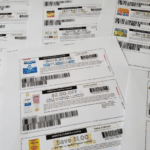
Spy something interesting on the shelf at your local grocery store? Well, smile – because the grocery shelf might be spying on you.
We already know that cameras can help deter shoplifters in grocery stores. But it turns out they can boost sales as well – just as long as you don’t mind being watched while you shop.
About 200 Meijer stores in the Midwest have rolled out interactive endcaps, displaying Purina pet food products. Powered by the retail marketing company Perch, the endcaps use computer vision to detect the presence of a shopper, who will be greeted with product information on a touchscreen monitor. Then, the endcaps will use what Perch calls “lift-and-learn” technology, to sense what product a shopper picks up, in order to display information specific to that item, allowing the shopper to interact with videos, product ratings and reviews.
“Shoppers can get more information about Purina products to help them find the right products for their pets by simply touching them as if they had clicked on them online,” Perch explains.
In theory, the displays could even incorporate coupons. One of the features of Purina’s campaign allows you to download any featured content onto your own mobile device, by scanning an on-screen QR code. Future campaigns could include a QR code that would allow you to download a digital coupon for the very product that the display senses that you’ve picked up.
Sounds great, as long as you don’t mind being watched by an endcap trying to get your attention as you walk by, or technology that Perch says “allows the brand to collect first party data on shoppers for future advertising.”
If it seems kind of creepy, well, these days it might also seem kind of commonplace. You already know there are security cameras trained on every aisle of most grocery stores. And in some sensitive areas like aisles of high-value products, or self-checkouts, there may even be monitors that show you on screen as a not-so-subtle reminder that you’re being watched.
The most notable implementation of cameras in recent years has been in Amazon Go stores, which use strategically-placed cameras and sensors to tally up what you put in your cart as you shop, allowing you to skip the checkout line. That technology rolled out for the first time in a full-sized Amazon Fresh grocery store in Washington state just last week.
But Perch’s technology isn’t aimed at thwarting shoplifters or allowing you to skip the checkout – it’s all about selling you stuff. And it’s just the latest example of marketers using technology to watch you – and sell to you.
A few years ago, IBM described its vision for a system that would use facial recognition technology to identify you as you walked into a store, pull up your purchase history and demographic information, then offer customized coupons and discounts. Soon after, NCR proposed its own system of “sensors and cameras located throughout the store” that would “monitor the customer’s location,” “identify products with which the customer interacts,” and use that information to “provide customized recommendations or promotions to the customer’s mobile device.”
And several years before that, a couple of companies put into practice ideas that were precursors to Perch’s platform. In 2017, the retail technology company Cloverleaf introduced shelf-based cameras that would scan your face to gauge your “emotional reaction” to a product display. And way back in 2013, snack food company Mondelez announced its plans for a “smart shelf” fitted with a camera that would determine your approximate age and gender and market to you accordingly, displaying an ad or promotion on screen for a product that might appeal to a shopper like you.
Those ideas never really took off. But Perch hopes its idea will. “We live in the most exciting era of retail, where technology and shopper marketing behavioral data are unlocking new ways for brands and retailers to collaborate and rapidly improve shopper experiences,” Perch CEO Trevor Sumner said in a statement.
So here’s hoping all this new technology makes your next shopping experience easier, and makes you a happy shopper. And if it doesn’t, smile anyway – because you never know when you’re going to be on camera.
Image source: Perch










